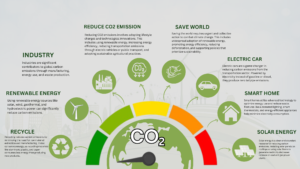In today’s climate-controlled business environment, the move to net zero emissions is recognized not only as an environmental necessity but as a business policy imperative. Organizations transition to corporate deficiencies in carbon due to increasing regulatory pressures, consumer demands, and urgent needs in order to address climate change , 1999 . It is embedded in the sustainable business practices, and its compliance is followed by companies across all industries
Understanding net zero emissions in an operating environment.
A state of net-zero emission occurs when the amount of greenhouse gases emitted into the atmosphere and the amount removed are in equilibrium Under operating conditions, this equilibrium can be achieved through a variety of reduction strategies on emissions and on a combination of carbon offsetting projects. The road to net zero emissions should be understood as a significant shift in overall business activity.
Business case for net zero emissions
Non-emissions methods can be viewed through several lenses:
Economic benefits:
- Improved energy efficiency greatly reduces operating costs
- Consistent practices increase market competition
- Investment opportunities are expanded through green financing mechanisms
- Brand value is underpinned by environmental commitments
Rules of Compliance:
- They ensure that they are future proof against stringent environmental regulations
- The carbon tax is reduced
- Regulatory risks are minimized through environmental management
- Reduces compliance costs through early adoption
Strategies for achieving net zero emissions
Efficient energy efficiency
The foundation of any net zero emissions program must be built on energy efficiency. Several basic features can be used:
- Smart technology is improving construction processes
- Manufacturing processes are being improved to save energy
- Lighting systems have been converted to LED technology
- HVAC systems are being modernized through energy-efficient methods
Renewable Energy Integration
The transition to renewable energy is accelerating across all sectors:
- Solar panels are installed on the roofs
- Wind energy is contracted through a power purchase agreement
- Geothermal systems have been used where possible
- Battery storage systems are being integrated to improve energy efficiency
Decarbonization of the Supply Chain
The net zero emissions can be spread across the supply chain:
- Suppliers have set sustainability standards
- Travel arrangements are being improved
- Packaging designs are being redesigned to become more sustainable
- Prioritize local sourcing options
Implementation guidelines for net zero emission
Part 1: Research and planning
A comprehensive assessment of current emissions is needed:
- Carbon footprint analysis is done
- Sources of emissions are identified and classified
- Prioritize discount opportunities
- Initial measurements are established
Part 2: Technology integration
The right technology should be selected and implemented:
- Energy management measures have been implemented
- Smart meters are being installed
- Data analytics platforms are being integrated
- Monitoring systems have been developed
Part 3: Optimization
Business processes need to be redesigned to be sustainable:
- They streamline product operations
- Improvements are being made to the waste management system
- Resources are being improved
- Employee training programs have been developed
Measuring and reporting progress
Key Performance Indicators (KPIs) .
Progress in net zero emissions should be tracked through specific metrics:
- Emission levels are controlled
- Energy consumption is analyzed
- The reduction in damage is measured
- Cost savings are calculated
Reporting System
Clear development communication is essential:
- Sustainability reports are published regularly
- Additional stakeholder information is provided
- Significant achievements are celebrated
- They deal with challenges clearly
To overcome common challenges
Financial crisis
The first set of financial problems can be solved by:
- Green funding options are being explored
- Government incentives are used
- Return on investment is calculated
- Approaches are adopted gradually
Technical complexity
Technical challenges can be solved by:
- Expert advice is sought
- Employee training programs are conducted
- Technology partners are involved
- Pilot projects have been implemented
Future ideas and opportunities for net zero emissions
Emerging Technologies
New opportunities are being found all the time:
- The use of artificial intelligence is under investigation
- Blockchain solutions are being considered
- Internet connectivity is being considered
- Advanced analytical tools are used
Market Development
The business landscape is changing rapidly:
- Consumer preferences are shifting towards sustainability
- Legal systems are becoming more stringent
- Competition in sustainable practices is intensifying
- New market opportunities are emerging
Example of a net zero emission company
An overview of Microsoft’s net zero emission efforts:
- Promise: In 2020, Microsoft promised to be carbon negative by 2030. This means that they aim to remove more carbon from the atmosphere than they emit.
- Carbon sequestration: Microsoft is actively investing in carbon capture technologies, including artificial forestry (planting trees) and soil carbon sequestration.
- Renewable Energy: They are buying renewable energy to power their operations and are working to be fully powered by renewable energy by 2025.
- Suppliers and manufacturers: Microsoft requires suppliers to report and reduce their emissions. It also ensures that its products and services help customers reduce their carbon footprint.
- Carbon fees: Microsoft collects carbon fees at its facilities, and reinvests the money collected into sustainability programs.
- Transparency: Publish annual sustainability reports to track their progress and share lessons learned with other companies.
Conclusion
The transition to net zero emissions represents a challenge and an opportunity for all businesses. Through careful planning, strategic implementation, and continuous monitoring, organizations can achieve their sustainability goals while maintaining a competitive advantage. Traveling to a place where carbon emissions are not limited to environmental responsibility; It’s about securing a sustainable future for business in an increasingly carbon-conscious world.
By adopting zero-carbon strategies, companies are not only contributing to global climate action, but also setting themselves up for long-term success in a zero-carbon economy. The tenure is now, and the benefits of early adoption cannot be overstated. Through commitment, innovation and determination, the zero-carbon goal can be achieved, delivering a sustainable and prosperous future for all stakeholders.
